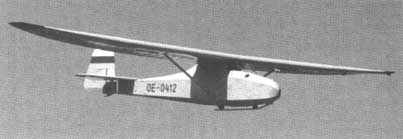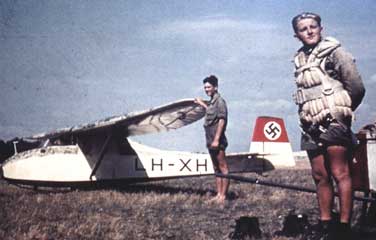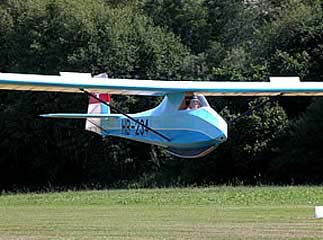Schneider Grunau Baby-Sailplane


Edmund Schneider designed the Grunau Baby and built the first examples at his factory near the village of Grunau, in the Silesia region of eastern Germany. Today, this area is part of western Poland and Grunau is called Jesow. Schneider built the first Grunau Baby in 1931. It was a smaller version of the ESG 31 Stanavo, a sailplane designed during the same year for American pilot Jack O'Meara.
Grunau Baby

 The first thing you will notice about a glider as
distinct from any other airplane is the length and narrowness
of the wings. This is because a glider depends entirely on its
wings which have to act on the greatest possible airflow to stay
airborne. Aspect ratio is the technical term used to describe
how long and slender a wing is from tip to tip and, for a rectangular-shaped
wing, this is expressed as the ratio of the span and chord (i.e.
distance from leading to training edge) lengths.
The first thing you will notice about a glider as
distinct from any other airplane is the length and narrowness
of the wings. This is because a glider depends entirely on its
wings which have to act on the greatest possible airflow to stay
airborne. Aspect ratio is the technical term used to describe
how long and slender a wing is from tip to tip and, for a rectangular-shaped
wing, this is expressed as the ratio of the span and chord (i.e.
distance from leading to training edge) lengths.
High performance gliders have high aspect ratio wings while low aspect ratio wings, like those on the Space Shuttle, have either short spans or thick chords. Swing-wing aircraft like the Grumman F-14 Tomcat, on the hand, has the best of both worlds as it can change its aspect ratio while flying - large span for low speed and small span for high speed.
A high aspect ratio wing has less drag and slightly more lift than a low aspect ratio wing. Because the glide angle of a glider also depends on the ratio of lift to drag, a glider is usually designed with a very high aspect ratio wing as seen here on this Grunau Baby.
On 3rd April 1933, a German glider pilot named Kurt
Schmidt soared a Grunau Baby 2 all day, all night, and into the
next day without landing. He had remained aloft for 36 hours and
36 minutes, a new world endurance record for motor less airplanes.
The news electrified the world and for the next ten years, Grunau
Baby 2 production continued without pause.
for motor less airplanes.
The news electrified the world and for the next ten years, Grunau
Baby 2 production continued without pause.
Edmund Schneider - who settled in Adelaide (South Australia) after the Second World War - designed the Grunau Baby and built the first examples at his factory near the village of Grunau (now called Jesow), in what was then the Silesia region of eastern Germany. To maintain control during a stall, Schneider designed the outboard wing and aileron with washout, or twist. On a wing with positive washout, the trailing edge of the wing curves up near the tips when viewed from the rear.
First flown in 1931, the Grunau Baby became the most popular glider of all time. Thousands were constructed in Western Europe between 1931 and 1945 and during World War Two, factory records showing that 4,104 rolled from workshops in Germany and the occupied countries. After the war, thousands more were built in Czechoslovakia, Spain, Sweden, Great Britain, and Australia. The Baby 2 was nearly a perfect club sailplane. It was relatively easy to build from plans, it flew well, and the aircraft was strong enough to handle mild aerobatics and the occasional hard landing. When the Baby first appeared, it was accepted wisdom that the pilot should feel as much unimpeded airflow as possible, the better to sense rising and falling currents of air, temperature changes and the like.
Fleets of Grunau Baby II B sailplanes served as primary flight trainers operated by the Deutsche Luftsport Verband (German Sport Flying Organization, the DLV) created in 1933. The DLV became the Nationalsozialistiche Fliegerkorps (NSFK) in 1937. The Nazi political machine operated both organizations to train military pilots without appearing to violate the Versailles Treaty that outlawed Germany's remilitarization. Many of the Luftwaffe (German Air Force) pilots that flew during World War Two first trained in Grunau Babies.
 Precise numbers are not known but various craftsmen
have probably built more Grunau Babies and Baby derivatives than
any other sailplane. Thousands were constructed in western Europe
between 1931 and 1945. During World War II, factory records show
that 4,104 rolled from workshops in Germany and the occupied countries.
After the war, thousands more were built in Czechoslovakia, Spain,
Sweden, Great Britain, and Australia. The Grunau Baby also influenced
the development of other sailplanes such as the Slingsby Kirby
Kite, Slingsby Cambridge 1 and 2, and the Slingsby Type 21 two-seat
trainer.
Precise numbers are not known but various craftsmen
have probably built more Grunau Babies and Baby derivatives than
any other sailplane. Thousands were constructed in western Europe
between 1931 and 1945. During World War II, factory records show
that 4,104 rolled from workshops in Germany and the occupied countries.
After the war, thousands more were built in Czechoslovakia, Spain,
Sweden, Great Britain, and Australia. The Grunau Baby also influenced
the development of other sailplanes such as the Slingsby Kirby
Kite, Slingsby Cambridge 1 and 2, and the Slingsby Type 21 two-seat
trainer.
Edmund Schneider designed the Grunau Baby and built the first examples at his factory near the village of Grunau, in the Silesia region of eastern Germany. Today, this area is part of western Poland and Grunau is called Jesow. Schneider built the first Baby in 1931. It was a smaller version of the ESG 31 Stanavo, a sailplane designed during the same year for American pilot Jack O'Meara.
Schneider used an innovative wing design patterned after the elliptical wings used on the high-performance sailplanes designed by the Academic Flying Group of the Darmstadt Technical University, the Akaflieg Darmstadt. Schneider's wing held a constant chord from the root to the aileron, and then the leading and trailing edges tapered to a rounded wingtip. To maintain control during a stall, Schneider designed the outboard wing and aileron with washout, or twist. On a wing with positive washout, the trailing edge of the wing curves up near the tips when viewed from the rear.

 Schneider continued to refine the airplane and introduced
the Baby II A and the definitive II B. The II A introduced a wing
of slightly greater span to accommodate spoilers for glide path
control, ailerons with a narrower chord, and for the first time,
a canopy and windscreen for the cockpit. When the Baby first appeared,
it was accepted wisdom that the pilot should feel as much unimpeded
airflow as possible, the better to sense rising and falling currents
of air, temperature changes and the like. On the II B, Schneider
changed the spoilers to the more powerful Schempp-Hirth, 'parallelogram'
configuration and added a wheeled launch dolly that the pilot
jettisoned immediately after takeoff. Other versions followed
but more Grunau Baby II B gliders were built than all other variants
combined.
Schneider continued to refine the airplane and introduced
the Baby II A and the definitive II B. The II A introduced a wing
of slightly greater span to accommodate spoilers for glide path
control, ailerons with a narrower chord, and for the first time,
a canopy and windscreen for the cockpit. When the Baby first appeared,
it was accepted wisdom that the pilot should feel as much unimpeded
airflow as possible, the better to sense rising and falling currents
of air, temperature changes and the like. On the II B, Schneider
changed the spoilers to the more powerful Schempp-Hirth, 'parallelogram'
configuration and added a wheeled launch dolly that the pilot
jettisoned immediately after takeoff. Other versions followed
but more Grunau Baby II B gliders were built than all other variants
combined.
The Baby II B was nearly a perfect club sailplane. It was relatively easy to build from plans, it flew well, and the aircraft was strong enough to handle mild aerobatics and the occasional hard landing. Novice pilots could attempt their first real soaring, flying high and far, using updrafts generated by slopes and mountain ridges, and spiraling columns of warm air called thermals. Many Grunau Baby II B pilots achieved the coveted Silver-C soaring badge introduced in 1930. This required a pilot to remain aloft at least five hours, gain a minimum of 3,280 ft after takeoff, and cover a horizontal distance of 31 miles.
May 1, 1949, marks the date when the U. S. Air Force officially transferred the Grunau Baby IIb to the custody of the National Air Museum. Very little is known of the glider's operational history. According to the data plates secured to the bulkhead behind the pilot's seat, this glider was built in 1944 at the Petera Hohenelbe l/Rsgb. workshop factory. The airframe serial number is 031.016 and the Stammkenzeichen, or registration code, LZ-NC is painted on both sides of the fuselage.
Details about how the U. S. Army Air Forces (AAF) recovered the glider are also unknown. For tracking purposes, the AAF assigned the inventory control number T2-2600. T2 signified the Technical Intelligence branch of the AAF. Beginning in the final months of the war, teams of Technical Intelligence personnel scoured Germany and recovered aircraft and pieces of equipment for study and evaluation.

 |
Cockpit of Grunau Baby. |
Specifications
 |
Length: 20 ft Wingspan: 44 ft 6 in Wing area: 153 ft² Aspect ratio: 13 Empty weight: 375 lb Gross weight: 550 lb Performance Maximum speed: 93 mph Maximum glide ratio: 17 Rate of sink: 180 ft/min |
 |
| Wednesday morning October 27, 1937 Michel Martin, crashes and is found on Sunday, 4 days later, he survived, however, severely injured and without water. |


